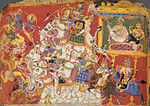Bhauma dynasty | |||||||
|---|---|---|---|---|---|---|---|
| Status | Legendary | ||||||
| |||||||
| Part of a series on the |
| Mythology of Pragjyotisha |
|---|
 |
| Ruling dynasties |
| Part of a series on the |
| History of Assam |
|---|
 |
| Categories |
The Bhauma dynasty is the second legendary dynasty of Pragjyotisha, after the Danava dynasty. Narakasura, who is said to have established this dynasty, and his descendants Bhagadatta and Vajradatta are first mentioned in the epics Mahabharata and the Ramayana in the sections that were composed in the first few centuries[1] though they place them variously in either northwestern or eastern India.[2] Narakasura's legend is further embellished in the locally composed Kalika Purana (10th–12th century), the Yogini Tantra (16th/17th century) and local lores and the legends became firmly attached to Assam and North Bengal. The late embellishment of the Naraka legends point to legitimization of the three dynasties of the Kamarupa kings.[3]
According to the 10th-century Kalika Purana, the dynasty was established by Naraka of Videha,[4] by removing the Kirata chief Ghataka, the last of the Danava dynasty.[5] The development of the details of the Naraka story are considered as myths[6] though historically he could have been a native Kirata chief,[7] or a Hinduized tribal youth.[8] The glorification and assimilation of a local chief and the making of myths follow a pattern that is observed in other parts of India.[9] The last ruler, Suparna, was killed by his ministers. The existence of this dynasty is not supported by any tenable evidence.[10]
- ^ "Though the composition of the two epics is supposed to have been completed in periods respectively from the fourth century BC to the fourth century AD and from the third century BC to the second century AD, the passages in question may not be much earlier than the beginning of the Christian era." (Sircar 1990, pp. 80–81)
- ^ (Sircar 1990, p. 81)
- ^ See section " The Naraka Legend and Political Legitimization" (Das 2014, pp. 154–156)
- ^ (Tripathi 2008, p. 41)
- ^ (Sircar 1990, p. 87)
- ^ "The details of the Naraka legend seems to suggest a development more or less on the mythical lines." (Sircar 1990, p. 84)
- ^ "It is contended that Naraka was a powerful Kirata chief whose feats had been magnified and myths created to prove his divinity to account for his supposed heroic (mis) deeds" (Das 2005, p. 225)
- ^ "With the blessings of Vishnu, Narakasura, a Hinduised tribal youth of Videha (North Bihar) destroyed this kingdom with the help of his own tribe and Alpine Hindus after a fierce struggle." (Sen 1984, p. 101)
- ^ "Just as in other parts of India, in Assam also, social groups and tribes initially considered to be outside the pale of the varnasramadharma had been assimilated into the fold of Aryan society after they had acquired political power. Thus, in the Brahmaputra valley, Naraka, a Kirata chief rose into prominence in the proto-historic period and became so powerful that the tales of his exploits remained in the collective memory of the people." (Das 2005, p. 225)
- ^ "Therefore, any claims of the existence of ancient Naraka-Bhagadatta or Bhauma-Naraka dynasty prior to the Varmans are historically untenable, albeit politically tenable."(Shin 2018, p. 29)
